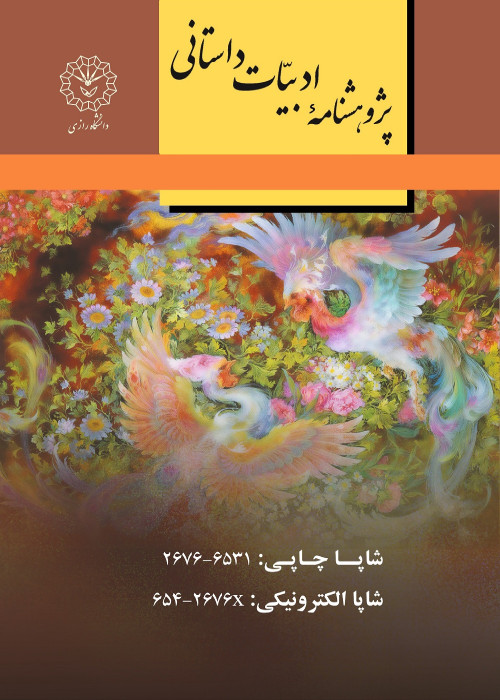Exploring the gothic in Esmail Fassih’s The Story of Javid
Author(s):
Article Type:
Research/Original Article (دارای رتبه معتبر)
Abstract:
Introduction
Since early decades of the 20th century, Persian novelists have made considerable efforts to provide native versions of various non-native narrative genres into their fiction. Since the introduction of the novel in Iran, writers such as Mohammad-Ali Jamalzadeh, Sadegh Hedayat, Bozorg Alavi, Bahram Sadeghi, Houshang Golshiri and many others have represented specific styles of narration and techniques to distinguish their works from their Western predecessors. Ismail Fassih, who is more famous for his crime fiction, has done something different in his novel, The Story of Javid, by creating a Gothic fiction, a genre that rarely appears in Persian fiction. In Gothic fiction, elements such as setting, character, and theme are used to create a certain effect in the reader. This article attempts to explore these elements in The Story of Javid by emphasizing the native aspects of this novel through a discussion of Fassih’s individual style of writing and the way his work connects to the social backgrounds of the mid-20th century Iran.Methodology
Gothic fiction appeared in the mid-18th century, but evolved in the subsequent centuries and still has its own audience. The genre has European origins and there have been various outstanding works of Gothic fiction since its introduction. This literary genre has not been practiced widely in Iran. Esmail Fassih is one the limited number of writers who have provided Gothic fiction. This article provides a brief history of the genre and defines some of its main elements as practiced by the major writers of the mode. Then, a close reading of The Story of Javid will be provided using the elements of the Gothic. In the meantime, a discussion of socio-political aspects of Fassih’s novel and the way they connect to the Gothic will be provided.Results and Discussion
Death is a key feature of Gothic fiction, which, in The Story of Javid, is intertwined with the setting and the themes of the story to create a sad atmosphere of stillness and decay. In most Gothic stories, death and fear appear simultaneously. In The Story of Javid, plot structure uses suspense, and the key events of the story are connected to death throughout the novel. The combination of fear and death in Gothic fiction serves to create a deeper effect in the audience. Horror accompanies death in the novel to create an atmosphere that is reminiscent of the unconscious states of the mind. In Gothic fiction, characterization moves along the axis of black and white and the result is that characters are flat and less developed. In The Story of Javid, the reader encounters flat characters who simply embody the good or the evil. The purity and innocence of characters such as Javid and Sorayya Khanum, and the mischief and hypocrisy of characters such as Malekara and Leila highlights the duality of black and white in the novel.Conclusion
Esmail Fassih creates a gothic narrative in The Story of Javid, which is not common in contemporary Persian fiction. The story takes place in the remote past and is part of a history that no longer exists. The novel depicts a large mansion which contains spooky spaces such as underground corridors and water storage. The atmosphere of the story contains death and scary events, and the flat characters display clear duality between good and evil. The duality of good and evil is the most obvious feature of the story that moves the characters forward. Fassih depicts an Iranian version of the Gothic. What separates his Gothic fiction from many Western examples is the social aspect of the story, which deals with the open oppression of the government agents to the defenseless people, especially to the Zoroastrian minority. Therefore, Fassih does not simply imitate the Gothic, but provides a Persian model that is reminiscent of characteristics of the genre, while its social context -which is rooted in a historical reality-remains native.Keywords:
Language:
Persian
Published:
Research of Fictional Literature, Volume:12 Issue: 4, 2023
Pages:
167 to 185
magiran.com/p2677019
دانلود و مطالعه متن این مقاله با یکی از روشهای زیر امکان پذیر است:
اشتراک شخصی
با عضویت و پرداخت آنلاین حق اشتراک یکساله به مبلغ 1,390,000ريال میتوانید 70 عنوان مطلب دانلود کنید!
اشتراک سازمانی
به کتابخانه دانشگاه یا محل کار خود پیشنهاد کنید تا اشتراک سازمانی این پایگاه را برای دسترسی نامحدود همه کاربران به متن مطالب تهیه نمایند!
توجه!
- حق عضویت دریافتی صرف حمایت از نشریات عضو و نگهداری، تکمیل و توسعه مگیران میشود.
- پرداخت حق اشتراک و دانلود مقالات اجازه بازنشر آن در سایر رسانههای چاپی و دیجیتال را به کاربر نمیدهد.
In order to view content subscription is required
Personal subscription
Subscribe magiran.com for 70 € euros via PayPal and download 70 articles during a year.
Organization subscription
Please contact us to subscribe your university or library for unlimited access!



